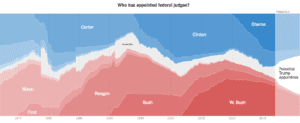Older Judges and Vacant Seats Give Trump Huge Power to Shape American Courts
Josh Katz, NYT, February 14, 2017

In the weeks since taking office, President Trump has derided court decisions as “ridiculous” and “disgraceful,” called the legitimacy of federal judges into question and encouraged people to blame the courts in the event of another terrorist attack.
But Mr. Trump could soon find himself responsible for appointing a greater share of federal court judges than any first-term president in 40 years, in large part because of a growing number of older judges and a stack of vacancies on the federal courts.
There are 870 Article III federal court judgeships, the vast majority on district courts or appeals courts like the one that recently upheld a halt on Mr. Trump’s immigration ban. These judges are appointed by the president and serve a lifetime term. (A few federal judges are appointed for limited terms.)
{snip}
It’s not just vacancies. The federal bench has many judges who are older than 70. Federal judges are appointed for life, but at a certain combination of years served and age, they become eligible to accept “senior status,” a form of semi-retirement. If a judge enters senior status, that creates an open seat. Though it is highly unlikely, if all the federal judges who are eligible take senior status during Mr. Trump’s first term, he could appoint half of the federal bench.
Conservatives are itching to counter eight years of Mr. Obama’s appointments. During his two terms and despite Senate sluggishness, he appointed about 40 percent of the federal judiciary. The pace of female and minority appointments to the federal bench continued to increase, enough so that as of February of last year, white men no longer represented a majority of active federal judges.
{snip}
It remains to be seen what kind of judges Mr. Trump will appoint to the federal bench. It’s fair to say that, given the number and pace of nominations to be made, Mr. Trump will probably not oversee the process personally, but will instead set guidelines for his staff to follow. Some presidents prefer a more decentralized approach; others set forth clear ideological litmus tests.
{snip}















